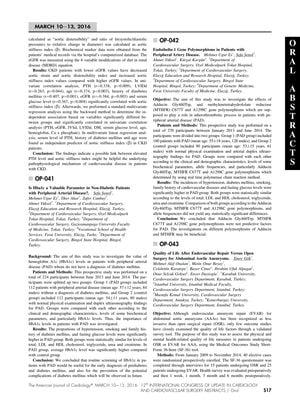Quality of Life After Endovascular Repair Versus Open Surgery for Abdominal Aortic Aneurysms
June 2016
in “
American Journal of Cardiology
”

TLDR Endovascular repair and open surgery for abdominal aortic aneurysms both result in a temporary decline in physical health, with no significant mental health difference, and a return to near normal health in 90 days.
The document reported on three studies, with the first indicating that lower eGFR values in CKD patients lead to increased aortic stiffness, influenced by PTH levels, diabetes, and age. The second study, with 224 participants, found that higher HbA1c levels in PAD patients could indicate undiagnosed prediabetes or diabetes. The third study, involving 270 participants, determined that certain gene polymorphisms were not predictive of PAD. Additionally, a study comparing quality of life post-EVAR and OSR for abdominal aortic aneurysms in 40 patients found that both procedures led to a decline in physical health at 30 days, with no significant difference in mental health, and a return to near baseline status by 90 days, with EVAR causing less decline. Another study concluded that endovascular therapy for occluded dialysis access is generally successful. None of the studies addressed hair loss, alopecia, or hair growth.